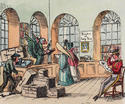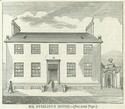 The earliest Glasgow public libraries took the form of commercial circulating libraries. John Smith, Trongate bookseller set up the first of these, in 1753 with 5,000 volumes and requiring an annual subscription of ten shillings. About the same time John Coubrough, High Street bookseller, opened his circulating library with 4,500 volumes loaned for "one penny per night". The first true free public library was probably the private library belonging to Walter Stirling (1723-1791) which he bequeathed to Glasgow Council for public use. Unfortunately, the funds set aside were inadequate to maintain it as a free library and it was obliged to change to a subscription library.
The earliest Glasgow public libraries took the form of commercial circulating libraries. John Smith, Trongate bookseller set up the first of these, in 1753 with 5,000 volumes and requiring an annual subscription of ten shillings. About the same time John Coubrough, High Street bookseller, opened his circulating library with 4,500 volumes loaned for "one penny per night". The first true free public library was probably the private library belonging to Walter Stirling (1723-1791) which he bequeathed to Glasgow Council for public use. Unfortunately, the funds set aside were inadequate to maintain it as a free library and it was obliged to change to a subscription library.
 The Glasgow Public Library opened in 1804 with a stock of more than 4,300 books of "Science, Literature, Taste" at annual subscription of ten shillings and sixpence. Its later fate was linked with the Stirling Library with which it merged in 1871. 1814 saw the opening of the Robertsonian Library. This was the very extensive theological collection of the Rev James Robertson of Kilmarnock and was thrown open to the public, again at an annual subscription of ten shillings and sixpence. Unfortunately not many years later it was spirited away to a theological library in Edinburgh. In 1820 the Glasgow Foreign Library opened, containing a collection of books in all the principal languages of Europe, at an annual subscription of twelve shillings. Glaswegians seemed to care little for "abroad" and the library barely lasted a dozen years.
The Glasgow Public Library opened in 1804 with a stock of more than 4,300 books of "Science, Literature, Taste" at annual subscription of ten shillings and sixpence. Its later fate was linked with the Stirling Library with which it merged in 1871. 1814 saw the opening of the Robertsonian Library. This was the very extensive theological collection of the Rev James Robertson of Kilmarnock and was thrown open to the public, again at an annual subscription of ten shillings and sixpence. Unfortunately not many years later it was spirited away to a theological library in Edinburgh. In 1820 the Glasgow Foreign Library opened, containing a collection of books in all the principal languages of Europe, at an annual subscription of twelve shillings. Glaswegians seemed to care little for "abroad" and the library barely lasted a dozen years.
 The Hunterian Museum and Library, established in 1807 and Scotland's oldest public museum, was left to his alma mater, the University of Glasgow, by William Hunter (1718-1793), a famous London anatomist and obstetrician. It included a library of over 12,000 volumes, works of art that included paintings by Titian, Rembrandt, Rubens, Canaletto and Stubbs, along with extensive and valuable coin and medal cabinets.
The Hunterian Museum and Library, established in 1807 and Scotland's oldest public museum, was left to his alma mater, the University of Glasgow, by William Hunter (1718-1793), a famous London anatomist and obstetrician. It included a library of over 12,000 volumes, works of art that included paintings by Titian, Rembrandt, Rubens, Canaletto and Stubbs, along with extensive and valuable coin and medal cabinets.